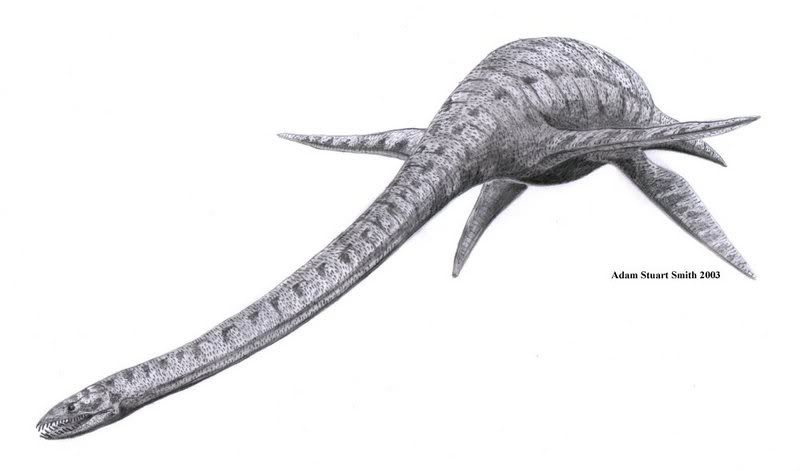Post by Barry the Baryonyx on Jun 25, 2007 23:44:25 GMT -5
Elasmosaurus

Elasmosaurus meaning "thin-plated lizard" because it had platelike bones in its pelvic girdle (Greek elasmos = thin plate + sauros = lizard) is a plesiosaur with an extremely long neck that lived in the late Cretaceous. It was about 14 m (46 ft) in length and weighed over 2,000 kg (2.2 tons), making it the longest plesiosaur. It had a large body and four flippers for limbs. More than half of its length was neck, which had more than 70 vertebrae, more than any other animal. It had a small head with sharp teeth, and most likely ate small bony fish, belemnites (similar to squid), lepidotes and ammonites (molluscs). It swallowed small stones in order to aid its
digestion. Elasmosaurus was described in 1868 by Edward Drinker Cope from a fossil discovered in Kansas, USA. Other specimens have been found in various locations in North America. In the 19th century, Edward Drinker Cope accidentally placed the head of an Elasmosaurus on the wrong end (the tail). Othniel Charles Marsh pointed out the error, and this event is often cited as one of the causes of their long-lasting and acrimonious rivalry, known as the Bone Wars. Cope published his erroneous reconstruction of Elasmosaurus in August 1869. This was the first time anyone had ever seen an elasmosaur and it appeared to have a long sinuous tail like a mosasaur. Note that while O.C. Marsh claimed to have pointed out Cope's error "20 years after the fact" in an 1890 newspaper article, it was Joseph Leidy who actually pointed out the problem in print in 1870. See: Leidy, J. 1870. [Remarks on Elasmosaurus platyurus]. Proceedings of the Academy of Natural Sciences of Philadelphia 22: 9-10.
Scientific classification
Kingdom: Animalia
Phylum: Chordata
Class: Reptilia
Order: Plesiosauria
Suborder: Plesiosauroidea
Family: Elasmosauridae
Genus: Elasmosaurus

Elasmosaurus meaning "thin-plated lizard" because it had platelike bones in its pelvic girdle (Greek elasmos = thin plate + sauros = lizard) is a plesiosaur with an extremely long neck that lived in the late Cretaceous. It was about 14 m (46 ft) in length and weighed over 2,000 kg (2.2 tons), making it the longest plesiosaur. It had a large body and four flippers for limbs. More than half of its length was neck, which had more than 70 vertebrae, more than any other animal. It had a small head with sharp teeth, and most likely ate small bony fish, belemnites (similar to squid), lepidotes and ammonites (molluscs). It swallowed small stones in order to aid its
digestion. Elasmosaurus was described in 1868 by Edward Drinker Cope from a fossil discovered in Kansas, USA. Other specimens have been found in various locations in North America. In the 19th century, Edward Drinker Cope accidentally placed the head of an Elasmosaurus on the wrong end (the tail). Othniel Charles Marsh pointed out the error, and this event is often cited as one of the causes of their long-lasting and acrimonious rivalry, known as the Bone Wars. Cope published his erroneous reconstruction of Elasmosaurus in August 1869. This was the first time anyone had ever seen an elasmosaur and it appeared to have a long sinuous tail like a mosasaur. Note that while O.C. Marsh claimed to have pointed out Cope's error "20 years after the fact" in an 1890 newspaper article, it was Joseph Leidy who actually pointed out the problem in print in 1870. See: Leidy, J. 1870. [Remarks on Elasmosaurus platyurus]. Proceedings of the Academy of Natural Sciences of Philadelphia 22: 9-10.
Scientific classification
Kingdom: Animalia
Phylum: Chordata
Class: Reptilia
Order: Plesiosauria
Suborder: Plesiosauroidea
Family: Elasmosauridae
Genus: Elasmosaurus


 Is it just us?
Is it just us?